
The 2018 FIFA World Cup, which will be held in Russia, is just around the corner with kick-off set for Thursday 14 June when the hosts play Saudi Arabia in Moscow.
As with every major football tournament, the ball itself is once again under the spotlight with comments from some goalkeepers that it wobbles too much when kicked.
Thankfully help is at hand from researchers at the Swiss Federal Laboratories for Materials Science and Technology (EMPA), who have been testing balls for FIFA for the last 22 years.
They have painstakingly put the 2018 World Cup ball – dubbed the Adidas Telstar 18 — through its paces. This includes being crushed 250 times in a water tank, being fired against a steel wall 200 times at 50 kilometres per hour to being measured at 4000 points around its circumference to make sure the ball is a perfect sphere.
While the ball passed all those tests, EMPA researchers also used a computer controlled “foot” to measure its trajectory when kicked. They found no evidence that it did wobble mid-air, so goalkeepers ought to have no excuse for any embarrassing mishaps. Just as well then that Liverpool shot-stopper Loris Karius isn’t in Germany’s squad after two catastrophic fumbles in last weekend’s 3-1 defeat against Real Madrid in the Champions League final.
Place your bets
Who will you be supporting from the 32 teams that have made it to Russia? Researchers at the University of Innsbruck have devised a model to predict the probability of your favourite team becoming world champions.
The model is based on the quoted odds from 26 bookmakers and betting exchanges and puts Brazil as the favourites with a 16.6% chance of winning. They are followed by Germany at 15.8% with Spain and France being the only other two teams having winning probabilities above 10%, at 12.5% and 12.1%, respectively.
The physics of football
The most likely final – with a 5.5% chance of happening – is a match between the top two favourites, Brazil and Germany. Perhaps it’ll be a chance for Brazil to avenge their humiliating 7-1 semi-final defeat against die Mannschaft at the 2014 World Cup.



